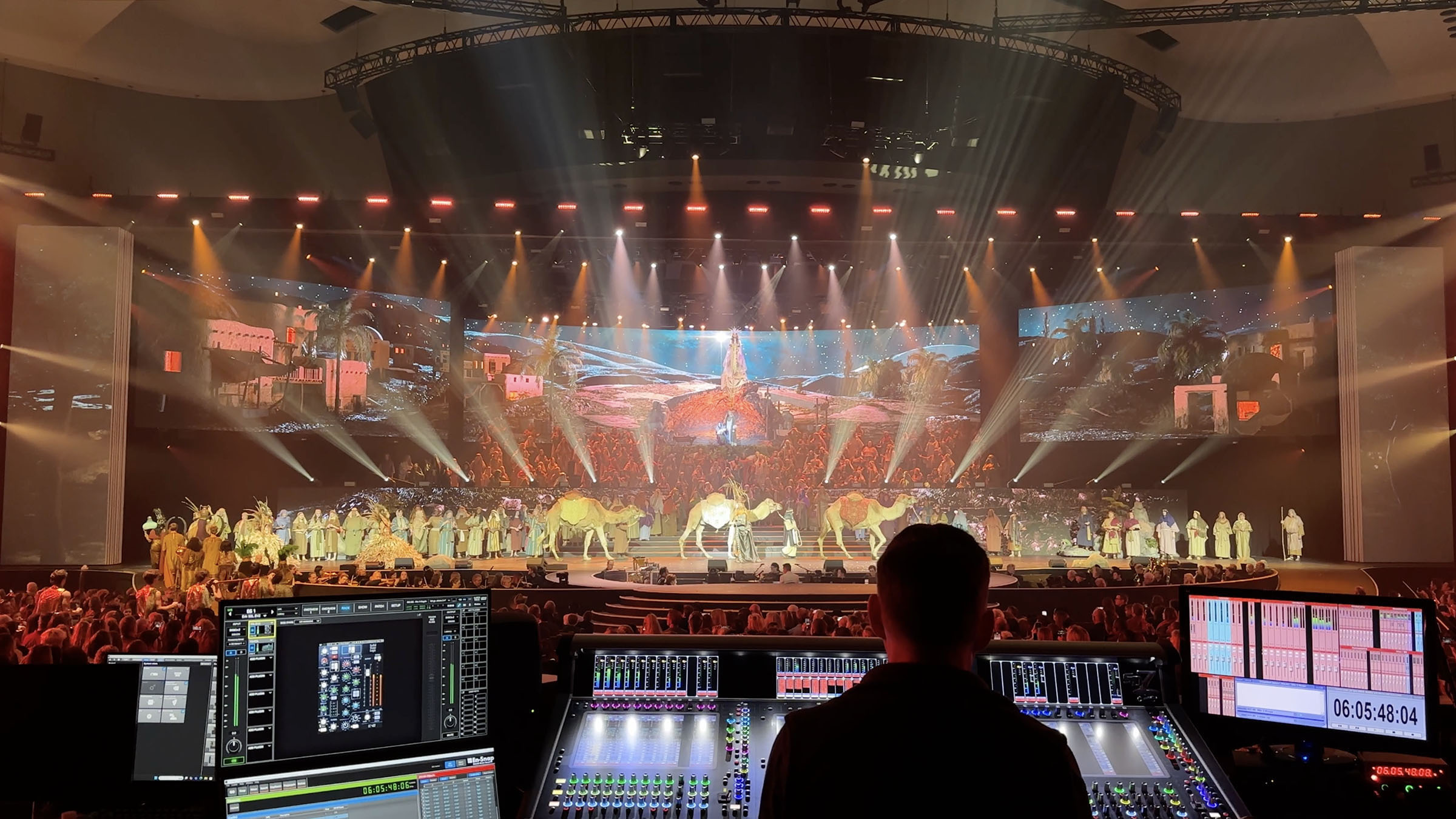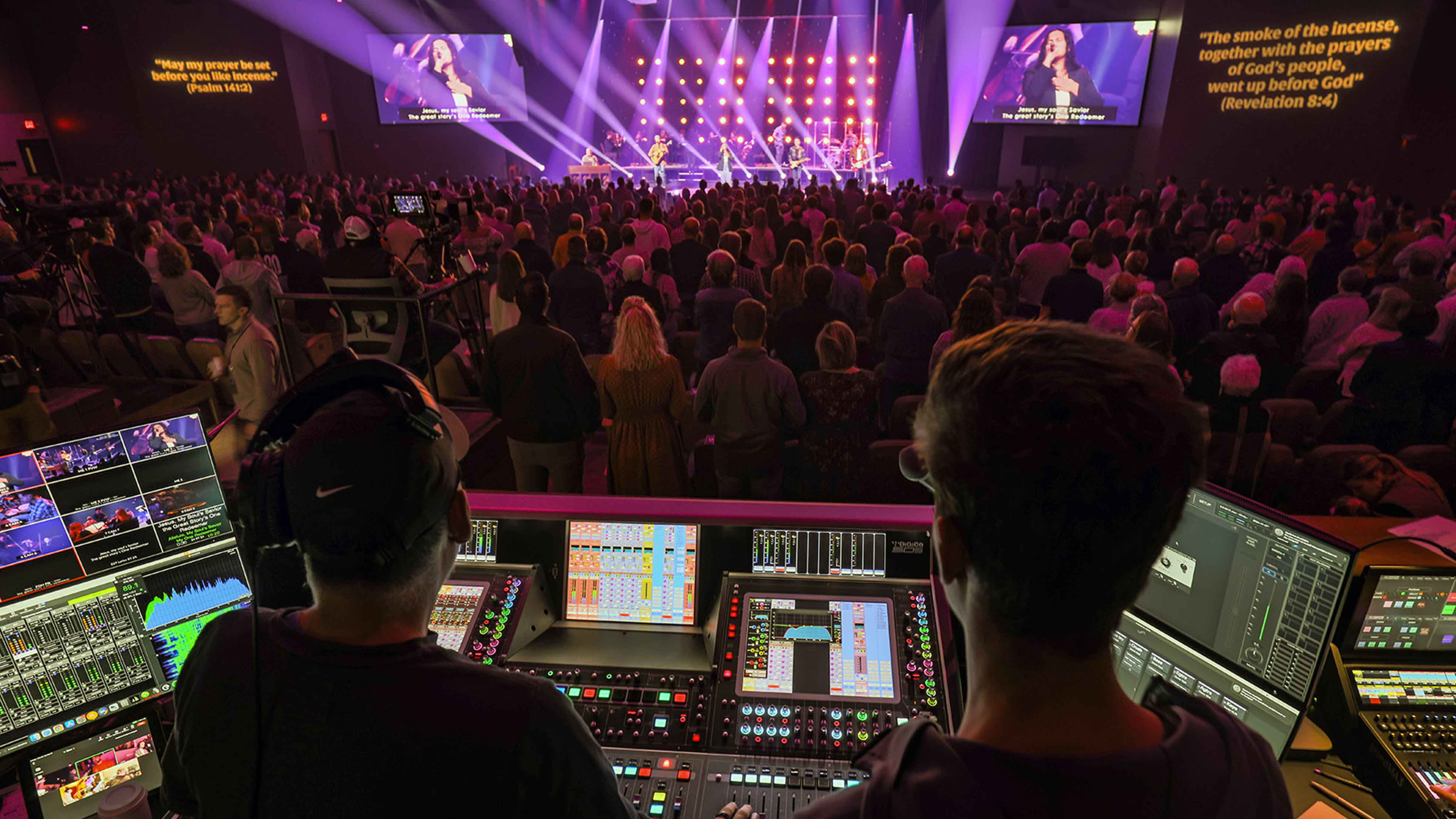
Architecturally, churches can range from elaborate cathedrals to converted retail spaces. Stylistically, they may strive to deliver professional concert-level musical performances or prefer more traditional, reserved worship. All of this means that when it comes to designing and integrating a solid audio system, there is no cookie cutter approach.
[Singing the Praises of High-End Audio]
While there is plenty of architectural variety, all houses of worship have one thing in common: Their congregants need to hear the message.
Prior to joining Meyer Sound, business development specialist Daniel Rivera spent 10 years as a church technical director. In the house of worship environment, he said speech intelligibility is the highest priority.
“The music is not the main event; the message is the diamond,” Rivera explained. “If you’re hearing your pastor—and hearing every word—you’re more than 80% there. Coverage is so important so that everyone hears the same thing at the same level. It’s the unicorn we chase.”
Part of that chase requires AV designers and integrators to get to know the church they’re serving. CTI's Robert Scott, branch director, and Scott Lopez, technical service director, believe that integrators can assume that houses of worship want to achieve clarity. Beyond that, it’s necessary for them to gain an in-depth understanding of that church’s worship style. How many musicians are on stage? How much does the pastor move around when he’s delivering the message? Is there a choir?
It’s also necessary for integrators to be familiar with different denominations—if they’re not, they need to ask questions and educate themselves if they’re going to make relevant recommendations.
The Universal Challenge

Whether it’s a cathedral, small historic church, or modern structure, acoustics are a primary issue. Josh Maichele, applications project director, house of worship, at L-Acoustics calls it the “universal challenge.” While companies have endeavored to keep energy off surfaces where it’s not wanted, there are a few reasons why the acoustics in many houses of worship are less than ideal—and there is only so much the technology can do to mitigate the problems found in a poor acoustic environment.
For example, in cathedrals featuring vaulted ceilings and marble surfaces, the architecture takes priority over acoustic considerations. “We just put speakers in Notre Dame [de Paris] and obviously, in an iconic and historical venue like that, there is no compromise for the aesthetics when it comes to the acoustics,” Maichele said.
Modern worship centers rely on donations and fundraising campaigns for their audio system deployments, and the expense of hiring a quality acoustician—and implementing the treatments they specify—can seem cost prohibitive. Instead, these facilities choose to invest in gear. “Acoustics is not a tangible thing that they can use," he offered, "so it’s hard for church leadership to understand where they should put their money.”
Zach Brady, business development manager at d&b audiotechnik, noted that even smaller churches can be “acoustically hostile” environments, with ornate features or glass, brick, and polished concrete surfaces. While it’s tempting to “tame” these spaces, it can become difficult to create engagement if you make the space too "dry" or quiet. When people can’t hear their fellow congregants singing along with them, they become self-conscious and tone down their participation. “This means we must strike a balance of a lively enough room to create engagement, but a controlled enough room to give us great direct sound without being drowned out by the reverberant field,” he explained.
Choosing the Right Loudspeakers
Highly reverberant worship spaces where aesthetics are prioritized often don’t require high SPL output. Achieving speech intelligibility is the fundamental goal in these environments; secondarily, they must support a choir and a piano.
In these scenarios, Maichele said column arrays work well because they don’t compromise the décor. “And they provide a bit more precise and direct sound to the listener,” he added.

Line source speakers are popular for their ability to direct the sound where it needs to be. While historically designated for large deployments, Maichele said nowadays there are line arrays that exist for almost any venue size. “All of them, in principle, are doing a similar thing, which is focusing the energy where we want it and keeping it away from where we don’t,” he explained. This applies to large worship centers, as well as shopping centers that have been converted into churches. He added that point source speakers complement line arrays, providing outfill, under-balcony, and front fill audio where wider coverage is required.
Many loudspeaker manufacturers offer sound mapping software that lets AV designers and integrators model their speaker configurations prior to installation. The benefits of these tools are obvious, but Maichele warned that they’re only as good as the data they ingest.
“Our ability to verify and validate what we’re doing is crucially important,” he explained. “The accuracy of the room being brought in means a lot. If the room model is inaccurate, ultimately the end result is going to be erratic or not ideal.”
It’s also necessary for integrators to confirm that the drawings they’re working with are up to date, which merits an on-site visit. If an integrator hasn’t been to the church prior to modeling the worship space, they may be surprised to discover elements that weren’t included in the original drawing set during installation. It’s not uncommon for churches to install LED displays or ceiling clouds, for example, long after the initial construction phase and without updating their documentation. When this happens, the integrator is forced to recalibrate their loudspeaker design, which may result in the need for more speakers, fewer units, or even a completely different system.
“There is something to be said for integrators to be on site with their customer,” Maichele said. “There’s the obvious relational aspect of them showing up and showing investment in what’s happening, but then there’s the ability to validate everything that we think we know.”
Affordable Immersive?
At front-of house (FOH), church audio engineers are seeking simplicity. “Nowadays, all the boards sound great and they have all these fun tools inside of them," said Lance Eddleman, application engineer for DiGiCo at Group One Ltd., a New York-based AV technology distributor that represents the U.K.-based audio console manufacturer. "But it’s really the integration side—being able to limit the amount of things you have to touch and bring it down to one simplified ecosystem.”
Another challenge houses of worship face is standardizing systems throughout their facilities (and, for multi-site churches, across all their locations). “Whether it be the main sanctuary, or their aux rooms, or their Sunday school classrooms, having one central ecosystem that they’re working in [is important],” Eddleman said.
While facilities across all markets strive to achieve standardization, it’s especially relevant in churches, which rely heavily on volunteer engineers with varying skill levels. “It makes it easy for their volunteers to learn one workflow and then work all the way through their environment,” he added.
And then there's the added potential wrinkle of immersive audio. When people think of immersive audio, they tend to envision loudspeakers around and above the audience. Maichele believes that this perception is rooted in the sound systems that homeowners install, where the audio surrounds the listener.
However, for the majority of house of worship environments, Maichele argued that immersive audio should focus on connecting the worshippers with the message that’s coming from the stage. Traditionally, church attendees have been accustomed to the disconnect between watching the pastor on stage and hearing his voice coming from somewhere else. A good immersive loudspeaker design can remove this barrier.
[The Integration Guide to House of Worship]
“It doesn’t require speakers all around us and above us,” he explained. “What it requires is the connection between the stage—and between the pastor and the worship pastors, and what’s happening in the room—and the congregation. To me, that’s immersion.”
Most importantly, accomplishing this doesn’t have to be more expensive than a more conventional loudspeaker setup. “And the return [on investment] for the congregation is huge,” Maichele added.
